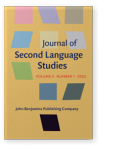Vol. 5:1 (2022) ► pp.34–57
The effects of prompt types on L2 learners’ textual emotionality and lexical complexity
This study investigated the role of prompt types in the emotion and lexical complexity level in L2 writing performance using fine-grained automatic textual analyzing tools and indices. Fifty-three ESL advanced-mid students wrote essays on pandemic (esp. COVID-19) and non-pandemic prompts. A textual Sentiment Analysis was carried out to detect both positive and negative emotions expressed in the students’ writing. A set of six lexical complexity indices was calculated to examine further the rarity, fluency, sophistication, and diversity levels in writing. The results revealed that the prompt types affect the emotional and lexical complexity of L2 writing. These results also showed that emotionality and lexical complexity have intricate and significant interactions, providing evidence for an emotion-lexicon link in L2 writing. Our results indicated that emotion has a substantial role in L2 writing beyond the traditional cognition-centered perspective, echoing the call of an ‘affective turn’ in second language acquisition (SLA) research.
Article outline
- 1.Introduction
- 2.Review of literature
- 2.1Effects of prompts on L2 writing quality and complexity
- 2.2Effects of prompts on emotion
- 2.3The role of emotion in SLA and its association with L2 writing
- 3.Method
- 3.1Participants and instructional context
- 3.2Prompts
- 3.3Procedure
- 3.4Sentiment analysis
- 3.5Lexical complexity measures
- 3.6Statistical analysis
- 4.Results
- 4.1Emotion scores
- 4.2Lexical complexity indices
- 4.3Emotion-lexicon link
- 4.4Re-examining lexical complexity with emotion controlled
- 5.Discussion
- 5.1Effects of prompt types on L2 learners’ textual emotionality
- 5.2Effects of prompt types on different facets of lexical complexity in L2 writing
- 5.3Relationship between emotionality and lexical complexity in L2 writing
- 5.4Implications, limitations, and future research
- 6.Conclusion
- Notes
-
References
